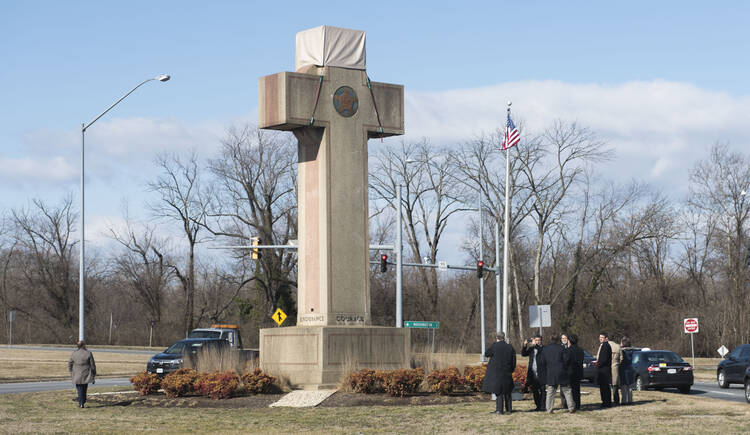The Supreme Court hears oral arguments in American Legion v. American Humanist Association on Feb. 27, a case that will decide whether the Bladensburg Peace Cross, a 40-foot Latin Cross located on government property and maintained with government funds, violates the Establishment Clause of the First Amendment. The lawsuit was brought by local residents who are offended by the presence of a Christian symbol in a public park in Prince George’s County, Maryland, and the use of taxpayer money to pay for that religious symbol. Various Christian, Jewish and Muslim groups have filed amicus briefs arguing both for and against the constitutionality of the Peace Cross.
In addition to resolving whether this particular cross may remain on government property, the case gives the court an opportunity to clarify the test used to determine when government-sponsored religious displays violate the First Amendment.
Is Lemon a lemon?
In Lemon v. Kurtzman (1971), the Supreme Court articulated a three-pronged test to determine when government action violates the Establishment Clause. “Per Lemon, to comply with the Establishment Clause, a challenged government display must (1) have a secular purpose; (2) not have a ‘principal or primary effect’ that advances, inhibits, or endorses religion; and (3) not foster ‘an excessive entanglement between government and religion.’” Failure to meet any one of these standards violates the Establishment Clause.
In the 48 years since Lemon was decided, the Supreme Court has questioned its importance, criticized it and ignored it, but has never completely repudiated it. As then-Chief Justice William H. Rehnquist noted in Van Orden v. Perry (2005), a decision that permitted a Ten Commandments monument to remain on government property:
“Whatever may be the fate of the Lemon test in the larger scheme of Establishment Clause jurisprudence, we think it not useful in dealing with the sort of passive monument that Texas has erected on its Capitol grounds. Instead, our analysis is driven both by the nature of the monument and by our Nation’s history.”
Most recently, in Town of Greece v. Galloway (2014), the court never even mentioned Lemon and instead applied a Van Orden analysis when it upheld opening prayers at town meetings: “[T]he Establishment Clause must be interpreted ‘by reference to historical practices and understandings’” without “permitting a practice that would amount to a constitutional violation if not for its historical foundation.”
The case gives the court an opportunity to clarify the test used to determine when government-sponsored religious displays violate the First Amendment.
One problem with the Lemon test, particularly with regard to religious displays such as Ten Commandment plaques and monuments, Nativity scenes, and crosses, is that the second prong—whether a display endorses religion—requires courts to decide the impact of the display on members of the public who view it. A common criticism is that this test inevitably leads to subjective decisions that give too much weight to offended observers and too little significance to the nation’s historic use of religious symbols to promote civic values. “[B]y making a constitutional claim out of feelings of offense and exclusion, the endorsement test grants a heckler’s veto,” argues the American Legion’s counsel.
Despite this criticism, the Fourth Circuit analyzed the Bladensburg Peace Cross “pursuant to the three-prong test in Lemon with due consideration given to the factors outlined in Van Orden” and found that the cross violates the Establishment Clause because “a Latin cross differs from other religious monuments, such as the Ten Commandments or the motto ‘In God We Trust.’ Those symbols are well known as being tied to our Nation's history and government, and courts have thus upheld their public display.” For the Fourth Circuit, it is the deeply sectarian nature of a cross as the universal and abiding symbol of Christianity that makes it improper for government display.
Supporters of the cross downplay its religious impact and argue that “the cross—has a ubiquitous and well-established meaning of commemorating military valor and sacrifice, especially when associated with World War I.” The American Legion, which dedicated the Peace Cross in 1925, disputes that the Fourth Circuit gave due consideration to time-honored memorial traditions and submits that Lemon should be replaced with a coercion test: “[T]he Court should clarify that the Establishment Clause is not violated absent government actions that pose a realistic threat to religious liberty—those that coerce belief in, observance of, or financial support for religion.”
The American Humanist Association contends that the Bladensburg Cross fails even this coercion test because “the Commission has poured $117,000 of taxpayer money into the Cross’s renovation and upkeep and has earmarked $100,000 for another substantial renovation project.”
The financial support dimension of this case evokes another Establishment Clause problem—standing to sue—that is not on direct appeal but could be raised during oral argument.
Standing to Sue
Constitutional provisions, such as the Establishment Clause, that restrict government action pose enforcement challenges because the government cannot be relied on to police itself. Government violations can be remedied only when the populace uses its political power to effect change or individual litigants convince the courts to order compliance. Every voter has political power, but the right to invoke judicial intervention is limited to those who have “standing,” which requires “a concrete and particularized” injury.
Taxpayers, whose suffering is universal, usually do not have standing to challenge government spending decisions. Despite this general rule, in Flast v. Cohen (1968), the Supreme Court created a limited exception when it permitted a taxpayer Establishment Clause challenge to government spending that aided religious schools. The court determined that the “Establishment Clause...operates as a specific constitutional limitation upon the exercise by Congress of the taxing and spending power.”
Flast v. Cohen has been applied sparingly, however, and the Bladensburg plaintiffs were granted standing on a completely different ground—the offense they felt by their regular observation of a prominent, and thus, unavoidable, government-funded religious symbol. The Fourth Circuit held that “in religious display cases, ‘unwelcome direct contact with a religious display that appears to be endorsed by the state’ is a sufficient injury.”
The Final Word
The Bladensburg Peace Cross is almost twice as old as the Lemon test by which it has been judged, but time itself may prove to be the monument’s mightiest foe. The concrete cross stands on a traffic median of a busy highway intersection and, despite a 1985 renovation and routine maintenance, is crumbling due to age and air pollutants. According to a brief filed with the court: “In 2012, a Commission official proclaimed: ‘Wow. Looks like another big chunk fell off it, so it may come down on its own!!’” The concrete has several large cracks and, just before Veteran’s Day 2018, a tarp was placed over its top to prevent dangerous crumbling. The Supreme Court will decide the cross’s constitutionality, but nature and budgetary limitations may determine its ultimate fate.











This blog is really great. The information here will surely be of some help to me. Thanks!. greatandhra telugu